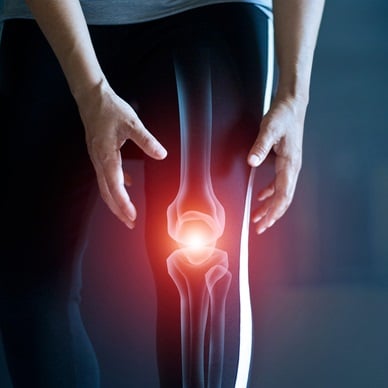Tech Neck: What is it + How to Get Rid of it?

In today’s modern society, you likely find your back and shoulders ache at the end of the day. You may find you get headaches more often than you’d like. You may even get numbness in your hands or fingers. The culprit—the dreaded tech neck.
Not sure what tech neck is? It’s that pain, soreness, or stiffness that comes from looking down or holding your head in a forward position to stare at a computer screen, tablet, or mobile phone for hours on end. And the more time you spend on devices, the more likely you’ll experience this common pain and discomfort. For some perspective, in America, the average person spends 7 hours and 50 minutes on devices, and that number is only expected to increase.
Consider this: If your head is in line with your spine, it’s like carrying 10 to 12 pounds. If you lean the head forward at just a 15-degree angle, it increases that weight to ~27 lbs; 30 degrees ups it to 40 lbs; 45 degrees, it’s nearly 50 lbs, and if you’re really leaning over your device at 60 degrees, it’s ~60 lbs. That increases the weight on your neck and shoulders by 400%! No wonder so many of us are in so much pain!
Indeed, tech neck has become epidemic for people of all ages. Go ahead and check in with your body right now. You can probably feel those muscles screaming for relief.
Beyond the pain and discomfort in the head, neck, shoulders, upper back, hands, etc., tech neck can affect the natural curvature of the spine. That is, it can lead to poor posture not just when you’re on your device but for the rest of the day. It can cause your neck muscles to lengthen as the chest muscles shorten. This throws off your balance, puts greater strain on the spine and neck, and makes other injuries more likely.
Symptoms of tech neck include:
- Back, shoulder, and neck pain or tension
- Neck spasms
- Headaches
- Curvature of the spine
- Pain in the jaw joints and muscles (aka TMJ or temporomandibular joint issues)
- Tingling in the hands or numbness in the fingers (due to a pinched nerve in the neck)
- Decreased grip strength
- Rotator cuff tendonitis
- Cranky, creaky shoulders
If left ignored and untreated, tech neck may even lead to arthritis or disk injuries in the neck and back. This is because the muscles remain tight to hold the head up, which puts pressure on the discs, which can cause them to wear out faster and potentially bulge or even rupture as well as pinch nerves, leading to pain and weakness in the arms and hands.
What to Do About Tech Neck
Fortunately, we don’t have to just accept that it is what it is. There are small changes we can make to help recover from and prevent tech neck. For one, we can cut back on the amount of time we use devices. In addition, it can help to be more mindful of our posture throughout the day to stand up straight and look straight ahead. If you work at a desk for much of the day, a standing desk, with the computer placed directly at eye level, can really help, especially if you use this time to focus on good posture.
When seated, it’s not enough to just keep your head directly over your spine and avoid looking down. As you’re working from a seated position, adjust your chair so you’re slightly reclined (25 to 30 degrees), so your back and shoulders naturally lean back and relax. Sit in a chair that provides lumbar support that allows your back to arch slightly but prevents slouching. This helps decrease the weight placed on your disks.
According to Dr. K. Daniel Riew, M.D., a renowned cervical spine surgeon, when seated at your desk, your neck should be positioned so it would naturally fall back (rather than forward) if you were to fall asleep. This puts much of weight into your chair rather than straight down your back and spine. Most of us do this naturally while relaxing yet try to “sit up straight” (and more often lean forward) while working. But allowing your body to recline slightly can greatly reduce the discomfort you often experience after a long work day.
When using handheld devices, likewise, hold or set your phone or tablet at eye level rather than looking down. If standing, the spine should be in a straight line from the top of your head to your tailbone, so your head is above your spine rather than leaning forward. As a bonus, holding your phone or tablet in front of your face can also help strengthen your arms.
You may want to consult an expert to help you set up your workstation so it’s more ergonomic. And your doctor or physical therapist may prescribe exercises to help you learn how to rebalance your body.
Tech Neck Stretches
If you’re already suffering from tech neck, you may be looking for immediate relief. And if not, you may want some exercises to help prevent pain or discomfort in the future. Here are four movements that may help. Shoot to do each exercise two to three times per day with six to ten repetitions each. (If, however, any of these make your discomfort worse, please stop and seek help from your doctor or physical therapist.)
1. Chin Tucks
Stand or sit up straight. While looking straight ahead, gently pull your head back, making you look like you have a double chin. Avoid tilting your head back as you do this—keep it level and parallel with the floor. Hold for a count of five. Relax and repeat.
BREAKING: The 3 Exact Nutrients Your Body Needs to Lubricate Your “Tin Man” Joints
2. Side-to-Side Neck Push
Start by standing or sitting up straight, looking directly ahead. Then place your left hand against your left ear. Tilt your head to the left shoulder while gently resisting with your left hand. Hold for five, relax, and repeat on the other side.
3. Head-to-Forehead Push
Start by sitting or standing up straight while looking forward with your chin parallel to the floor. Then place both of your hands on your forehead and push your forehead against your hands as your hands gently resist. Hold for another five counts, relax, and repeat.
4. Yoga Cobra Pose
Begin by lying down flat on the floor on your stomach with your face looking down into the mat. Place your hands on the outside of your shoulders and then push your upper body up, lifting your head and chest and pushing into the ground with your hands as you relax your shoulders down your back. Hold for 5 to 30 seconds as you breathe deeply.
Other useful yoga poses to help relieve and prevent tech neck include downward-facing dog, fish pose, cat-cow, and boat pose.
Beyond the specific neck exercises and stretches, a regular fitness routine incorporating aerobic exercise and weight training can also help. Cardio will help send oxygenated blood into your muscles to help flush away toxins that lead to excess inflammation and pain. And regular weight training will help improve stamina and resilience.
Most importantly, no matter what you are doing, throughout the day, take regular breaks. Stand up, move around, roll your head, stretch your shoulders, and roll them back as you shift your head back and look up to counteract all the forward posturing many of our activities lead to. Do this at least once an hour throughout the day to get the blood flowing and adjust your body into a different position.
While you’re at it, limit the amount of time you focus on a screen during the day. If you spend your workday focused on a computer, find other things to do in your downtime away from a device. For example, enjoy nature walks, go to the gym, do some yoga or meditation, or hang out with friends or family face to face. Heck, if you’re feeling sleepy, take a nap. Just give your back and neck a nice break.
The goal is to relieve the pressure off your back and neck and give your shoulders, neck, and back a chance to relax to counteract all the stress you place on it throughout a typical day.




 US Doctor: "Eating This Every Day Can Snap You Into Ketosis"
US Doctor: "Eating This Every Day Can Snap You Into Ketosis" 3 Key Nutrients to Help Lubricate Your "Tin Man" Joints
3 Key Nutrients to Help Lubricate Your "Tin Man" Joints AVOID Plant-Based Protein Powders (unless...)
AVOID Plant-Based Protein Powders (unless...)

